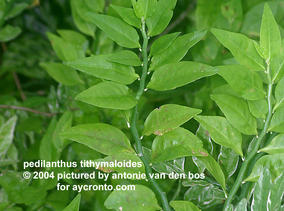You are here
Neotropical Euphorbiaceae s.l.
Euphorbia
SUMMARY
Trees, shrubs or perennial, biennial or annual herbs, succulent or not, root sometimes tuberous (plant geophytic), monoecious or rarely dioecious. Stems smooth or angled, rarely flattened. Exudate (from cut stems) present, milky, white or very rarely yellow, often strongly caustic. Armed (spiny or with prickle-like stipules) or unarmed. Glabrous throughout or indumentum present, hairs simple (rarely multicellular). Stipules absent, or present, minute, free*, fused-interpetiolar or -intrapetiolar*, simple, unlobed, entire *, spine-like or not, not leaf-like*. Leaves distributed evenly along stem, alternate, opposite or whorled, simple, unlobed, base symmetrical, margin toothed or entire, blade not pellucid-punctate; venation pinnate or with 3 or more strong veins from base; domatia absent*; stipel-like structures absent*; leaves sometimes minute and falling early. Petiole present, or absent (leaves sessile), without swellings or bends at base or apex*, without glands*. Inflorescence usually with axis, complex, consisting of one or more cyathia, each cyathium with 2 variously-coloured free or connate modified leaves; bracts fused into cup- or funnel-like involucres, or sometimes calyx-like, involucres glandular, lobate; involucral glands (1–2) 4–5 (8), alternating with the lobes, erect or spreading, free or fused, entire, 2-horned or -spurred, usually fleshy, variously coloured; male flowers few to many, female flower solitary; pedicels absent (sometimes in female flowers) or present, not articulated*. Male flowers: pedicels present, persistent; sepals 0, petals 0; disc 0; stamens 1; anther without conspicuous modification, thecae introrse in bud; pistillode absent. Female flowers: pedicels absent, or present, elongating and reflexing in fruit, becoming erect again before dehiscence; sepals 3, greenish, partially or completely fused, or calyx minute, rim-like; petals 0; disc 0; ovary locules 2–3, ovules per locule 1; styles 2–3, free or partially to completely fused (stigmas free), entire or 2-branched (i.e. ultimate divisions per locule 2), stigmas not flat*, surface smooth*; staminodes absent. Fruit dehiscent, smooth, horned, warty, rarely winged, greenish to brown; seed with or without caruncle, with no other covering or membranous layer; embryo flat, not minute, cotyledons leaf-like.
An asterisk * indicates a state has been assumed but not yet confirmed.
About 2,250 species. One of the 5 largest genera of angiosperms.




